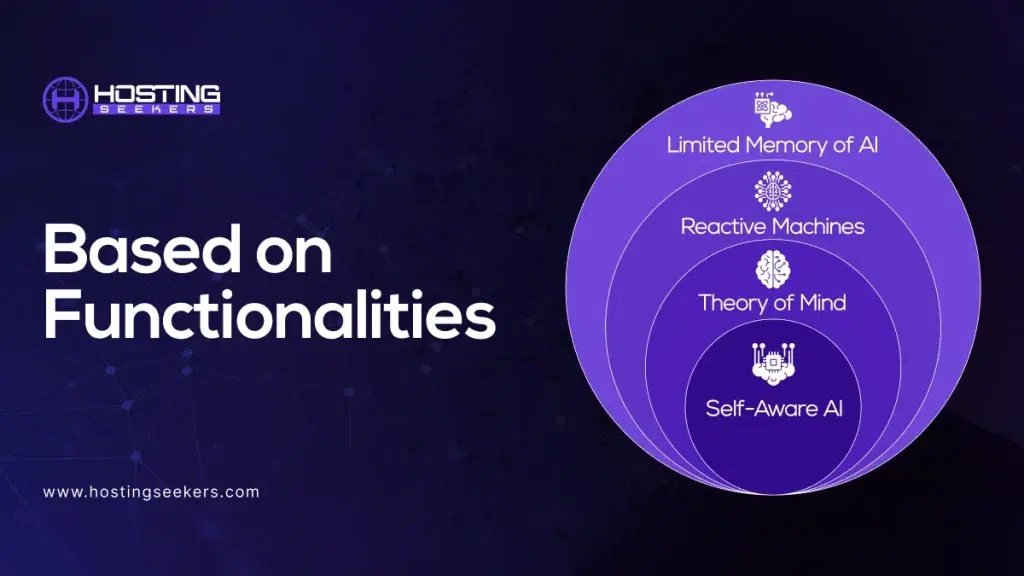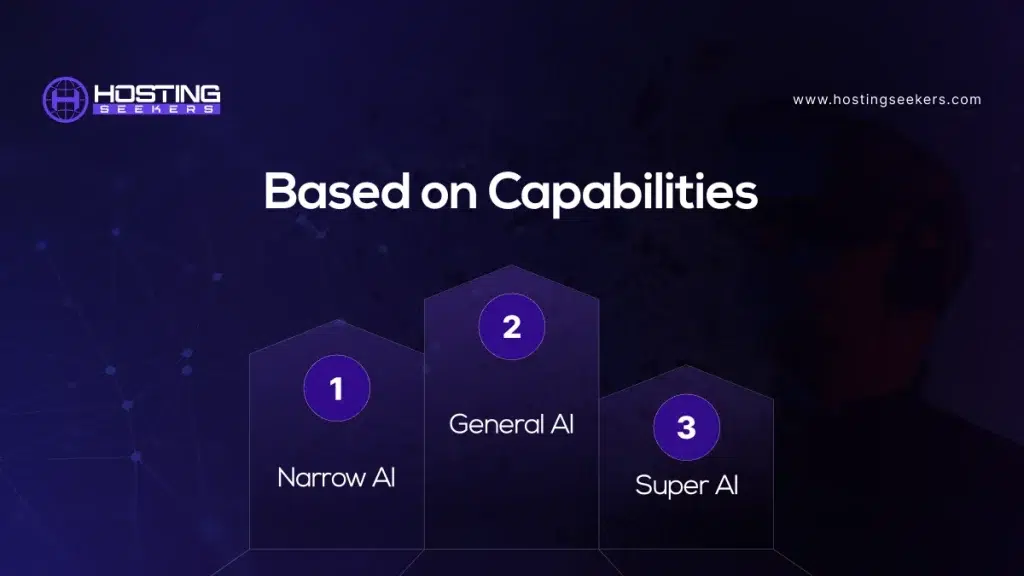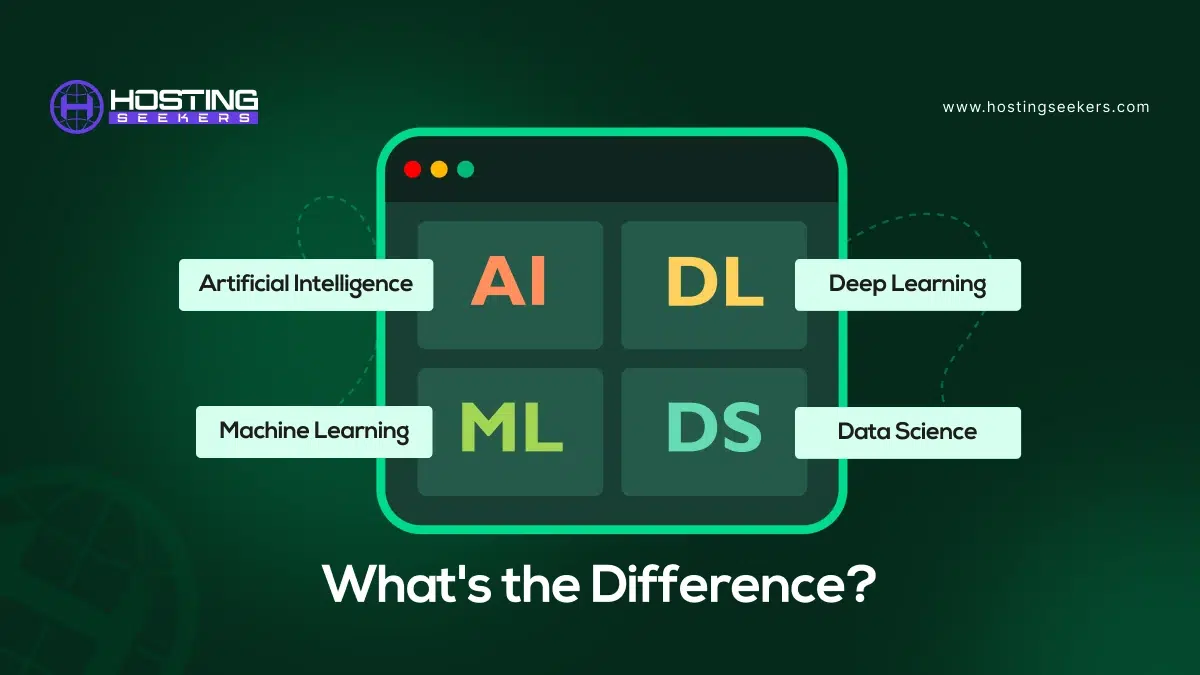
AI vs ML vs DL vs DS: What’s the Difference?
IT Updated on : July 3, 2025As technology changes rapidly, so does the importance of Artificial Intelligence, Machine Learning, Deep Learning, and Data Science. In this article, we will explore the fundamentals and comparison of AI vs ML vs DL vs DS. We will uncover the intricacies of each domain and gain an overview of how these innovations and technologies shape the future of intelligent systems.
What is AI?
Artificial Intelligence is a technology that enables computers to perform various functions, including the ability to perceive, comprehend, and interpret written and spoken language, analyze data, make recommendations, and more.
Self-driving cars and robots are the best examples of AI. Well, AI is a broad field that encompasses various disciplines, including computer science, data analytics, statistics, hardware, software engineering, and more.
Nowadays, most AI experts and news stories are mainly focused on generative AI, which can create original text, images, videos, and more. Platforms like ChatGPT and Gemini are perfect examples of generative AI where you can generate text and images immediately.
Artificial Intelligence Stats
The market for AI technologies is vast, accounting for around $244 billion in 2025, and is expected to grow significantly to over $800 billion by 2030. (Statista)
The AI market is expanding with a CAGR of 35.9%. By 2025, as many as 97 million people are expected to work in AI space. Also, 83% of organizations claim that AI is a top priority in their business plans. Additionally, ChatGPT reached approximately 1 million users in five days, and as of 2025, it has garnered over 5 billion visits. (explodingtopics)
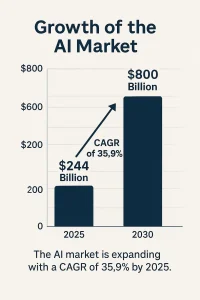
Types of Artificial Intelligence
Artificial Intelligence has a broad impact on various industries, leading to significant advancements in science, technology, and our day-to-day life. Well, AI is categorized into different types depending on its functionalities and capabilities.
Based on Functionalities
- Reactive Machines
- Limited Memory of AI
- Theory of Mind
- Self-Aware AI
Based on Capabilities
- Narrow AI
- General AI
- Super AI
Based On Functionalities
1. Reactive Machines
This is a basic form of artificial intelligence that operates based on current data and does not store any past actions. One of the best examples of reactive machines is IBM’s Deep Blue, a chess AI system that defeated Garry Kasparov, a world chess champion, in the late 1990s.
Deep Blue could identify its own and its opponent’s pieces on the chessboard to make predictions. Still, it didn’t have the memory capacity to learn from past mistakes and inform future decisions.
2. Limited Memory AI
Limited Memory AI can learn from past data to improve future responses. Most modern AI apps fall under this category. It utilizes historical data to make predictions and decisions but doesn’t have long-term memory.
Self-driving cars are the best examples of limited memory AI. These vehicles observe other cars on the road for direction, speed, and proximity. This information forms the basis of the car’s representation of the world, enabling it to recognize signs, understand traffic lights, and anticipate potential hazards on the road. The data helps the car to decide when to make diversions or change lanes
3. Theory of Mind AI
Theory of Mind AI focuses on understanding desires, beliefs, aims, human emotions, and behaviors. It allows machines to interact in more sophisticated ways by understanding emotions and adjusting behavior accordingly.
In the future, the theory of Mind AI machines may enable them to understand and predict behavior, as well as comprehend intentions, effectively simulating human behavior.
4. Self-Awareness AI
Self-awareness AI is an advanced stage of AI that includes awareness and self-consciousness. This type of AI may have the ability not only to understand and react to emotions but also to possess its consciousness, much like human awareness.
While we are far from achieving self-aware AI, it remains the end goal for AI development. It opens philosophical debates about identity, consciousness, and the rights of AI systems if they ever reach this level.
Based On Capabilities
1. Narrow AI
This type of AI is developed to perform particular tasks. They are designed and trained for a specific purpose but cannot perform general tasks effectively. Alexa and Siri voice assistants are prime examples of Narrow AI, which is designed to understand a particular task or set of functions.
2. General AI
General AI refers to AI systems that incorporate human intelligence and capabilities to perform various tasks. Systems can learn and understand across a wide range of functions, much like humans can perform multiple tasks. It requires a machine to possess consciousness, self-awareness, and the ability to make independent decisions, which is not yet achievable..
3. Super AI
Super AI mainly focuses on solving human-related issues. It develops its desires, emotions, and beliefs. Super AI is capable of making decisions independently and resolving problems. AI would not only be able to complete tasks more effectively than humans but also understand and interpret emotions and act in a more human-like manner.
Usage of Artificial Intelligence
1. Virtual Assistants and Chatbots
AI is utilized in AI-generated assistants like Alexa, Siri, and Google Assistant to set reminders, answer queries, and perform other tasks.
2. Healthcare & Medicine
In healthcare, AI enables doctors to predict and detect diseases and health problems easily and suggest effective treatments.
3. E-commerce & Recommendations
AI is used in product recommendations based on your preferences and the types of products you have previously purchased.
4. Autonomous Vehicles (Self-Driving Cars)
AI helps self-driving cars see the road, avoid diversions, and contribute to safer driving.
What is Machine Learning?
Machine learning is a branch of artificial intelligence that enables algorithms to identify hidden patterns within specific datasets. It will allow them to predict new or existing data.
Machine learning is applied to various tasks, including speech recognition, natural language processing, recommendation systems, portfolio optimization, fraud detection, and automating repetitive tasks.
Machine Learning Stats
The global machine learning market size is estimated to reach $419.94 billion by 2030, increasing at a CAGR of 33.2% from 2025 to 2030. Additionally, the services segment accounted for the largest revenue share of 54.1% in 2024 ( Grand View Research) 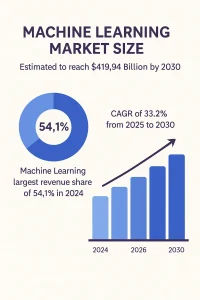
Types of Machine Learning
1. Supervised Machine Learning
In this type, the model is trained on a labeled dataset that has both input and output parameters. Additionally, supervised machine learning algorithms enable the model to learn how to map points between the input and the correct outputs. It has both training and validation datasets labeled.
For instance, if data scientists are developing a forecasting model, the input variables might include location, temperature, wind flow patterns, and more, and the output would be the actual weather activity recorded for those days.
2. Unsupervised Machine Learning
This type of machine learning involves an algorithm for discovering patterns and algorithms using unlabeled data. It doesn’t include providing the algorithm with labeled target outputs.
For instance, if you have a dataset that includes information about the purchases you made from the shop. With the help of clustering, the algorithm can group similar purchasing behaviors among you and other clients, revealing potential clients without predefined labels.
3. Reinforcement Machine Learning
Reinforcement machine learning is a learning method that interacts with the environment by producing actions and learning from the resulting errors. Delay, trial, and error are the most relevant characteristics of reinforcement learning.
In this technique, the model continually improves its performance by using reward feedback to learn patterns or behaviors. For example, you are developing an AI agent to play chess. The agent explores various moves and receives feedback, either positive or negative, depending on the outcome.
4. Semi-Supervised Machine Learning
This type of machine learning falls between supervised and unsupervised learning, utilizing labeled data. It is beneficial when obtaining labeled data is costly, time-consuming, or resource-intensive. This approach is practical when the dataset is large and requires more time to process.
Usage of Machine Learning
1. Predictive Modeling
Machine learning can be utilized to develop predictive models that enable businesses to make more informed decisions. For instance, machine learning can be used to predict which clients are more likely to purchase products, or in the healthcare sector, it can help to indicate a particular disease.
2. Natural Language Processing
Machine learning is used to develop systems that can easily understand and interpret human language. This is crucial for applications such as chatbots, voice recognition, and language translation.
3. Computer Vision
Another application of machine learning is the development of software and systems that can resolve issues and understand images and videos. This is vital for self-driving cars, surveillance systems, and medical imaging.
4. Fraud Detection
Machine learning can be applied to fraud detection in financial transactions, online advertising, and other critical areas of business.
What is Deep Learning?
Deep learning is a subset of machine learning that utilizes multilayered neural networks, known as deep neural networks, to simulate the complex decision-making capabilities of the human brain.
Just like the ML model, deep learning requires a large amount of data to learn and make informed decisions, and is, therefore, also considered a subset of ML. This is one of the primary reasons for the misconception that ML and DL are the same.
Types of Deep Learning Models
Deep learning models can automatically learn features from data. This makes them ideal for image and speech recognition, as well as natural language processing tasks.
1. Convolutional Neural Networks (CNNs)
Convolutional Neural Networks are specifically designed and developed for video and image recognition tasks. CNN can automatically learn features from images, making them well-suited for object detection, image classification, and image segmentation tasks.
2. Feedforward Neural Network (FNN)
Feedforward neural networks are among the basic types of Artificial Neural Networks (ANNs), employing a linear information flow through the network. FNNs are extensively utilized for image classification, speech recognition, and natural language processing.
3. Recurrent Neural Network (RNN)
Recurrent Neural Networks process sequential data, such as natural language and time series. RNNs can maintain an internal state that collects information about previous inputs, making them ideal for speech recognition, language translation, and natural language processing tasks.
Usage of Deep Learning
1. Image and Facial Recognition
Deep learning is utilized in smartphones, social media platforms, and security systems to identify and authenticate individuals.
2. Autonomous Vehicles
Self-driving cars utilize deep learning to recognize traffic signs, detect objects, and make driving decisions.
3. Healthcare and Medical Diagnosis
AI-powered models aid in detecting diseases, such as cancer, by analyzing medical images, including MRIs and X-rays.
4. Natural Language Processing (NLP)
Voice assistants like Alexa, Siri, and Google Assistant use deep learning for speech recognition.
Comparison Table: AL vs ML vs DL
| Aspect | Artificial Intelligence (AI) | Machine Learning (ML) | Deep Learning (DL) |
| Core Focus | Aims to create intelligent systems that can mimic human reasoning and behavior. | Utilizes algorithms to identify patterns in data and make informed decisions or predictions. | Mimics the human brain using layered neural networks to process complex data. |
| Relation | It includes ML, DL, robotics, expert systems, and more. | A subset of AI that enables systems to learn from data without explicit programming. | A specialized subset of ML focused on deep neural networks and large-scale learning. |
| Human Involvement | Often requires human-defined rules, decision logic, and feedback mechanisms. | Requires humans to select features, tune algorithms, and prepare data. | Requires minimal human input, automatically extracts features from raw data. |
| Data Requirements | Can work with smaller or symbolic data; less dependent on data size. | Needs structured and labeled data for effective learning. | Requires massive volumes of labeled data for training and high accuracy. |
| Technical Complexity | Ranges from simple rule-based systems to knowledgeable agents. | Moderate complexity; easier to develop and interpret than DL. | Very complex; needs careful tuning, architecture design, and training expertise. |
| Computational Needs | Can run on basic to moderate hardware, depending on the use case. | Requires decent processing power (CPUs/GPUs) for efficient training. | Demands high computational resources (GPUs/TPUs) for training deep models. |
| Typical Use Cases | Virtual assistants, intelligent robots, chatbots, gaming AIs, expert systems. | Spam detection, price prediction, product recommendations, and fraud detection. | Image classification, speech recognition, self-driving cars, and real-time translation. |
What is Data Science?
Data science is a combination of specialized programming, statistics, and mathematics, as well as artificial intelligence and machine learning, with subject matter expertise, to uncover robust insights hidden in an organization’s data. These insights can inform decision-making and strategic planning.
Data Science involves these key steps;
1. Data Collection
Gathering raw data from different sources such as sensors, databases, or user interactions.
2. Data Cleaning
It ensures that your data is clean, accurate, complete, and ready for analysis.
3. Data Analysis
It applies statistical and computational methods to identify trends, patterns, or relationships.
4. Data Visualization
It creates graphs, charts, and dashboards to present findings clearly and concisely.
5. Decision-Making
It uses insights to create solutions, inform strategies, or predict outcomes.
How Data Science is Different From AI, ML, and DL?
Data science is a vast, multidisciplinary field that mainly focuses on extracting valuable insights and knowledge from raw data. It encompasses a combination of statistics, data analysis, data visualization, and domain expertise to identify trends, patterns, and relationships within the data.
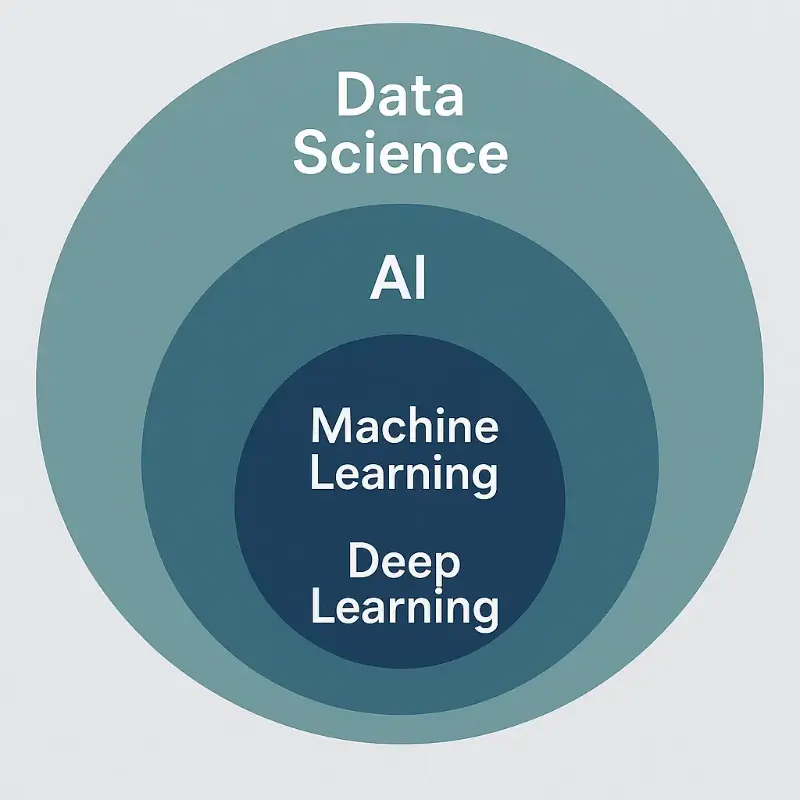
Unlike artificial intelligence, which aims to develop and create systems that can simulate human intelligence and perform tasks such as reasoning, problem-solving, and learning, data science is more about making sense of data and utilizing it to inform decision-making.
Additionally, AI encompasses a much larger umbrella that includes technologies such as Deep Learning (DL) and Machine Learning (ML). Data science often utilizes these tools as part of its workflow. Also, Machine learning is the subset of AI that involves developing models that can learn from data and make predictions or decisions without being explicitly programmed.
Deep Learning, in turn, is a subset of ML that utilizes complex neural networks to manage and handle tasks, including large volumes of unstructured data like audio, images, and text. Therefore, Data science primarily focuses on analyzing and interpreting data. At the same time, AI (along with ML and DL) concentrates on developing systems that act intelligently, sometimes by utilizing the very insights that data science uncovers.
AI vs ML vs DL vs DS: Summarized Comparison
| Term | Is a Subset of | Focus | Key Tools/Methods |
| Data Science | — | Insights from data | Statistics, visualization, ML |
| AI | Broadest | Simulating human intelligence | ML, NLP, robotics, planning |
| ML | Subset of AI | Learning from data | Regression, classification, clustering |
| DL | Subset of ML | Neural networks, high computation | CNNs, RNNs, transformers |
Summing UP
To conclude the comparison of AI, ML, DL, and DS. Artificial Intelligence (AI) is the overarching field that focuses on building machines that can think and act like humans. Machine Learning is a subset of AI that allows systems to learn from data without being explicitly programmed. Taking it a step further, Deep Learning (DL) is a specialized area within ML that utilizes complex neural networks to handle massive amounts of unstructured data like audio, images, and natural language.
On the other hand, Data Science (DS) stands apart as a broader discipline that focuses on extracting meaningful insights from data using statistical analysis, visualization, and modeling techniques, which may include AI/ML methods. Moreover, AI, ML, and DL are primarily focused on building intelligent systems. Data science involves understanding and interpreting data to inform decision-making.

